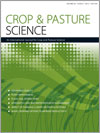CP13080Waterlogging in Australian agricultural landscapes: a review of plant responses and crop models
This review of waterlogging in the Australian landscape examines potential for occurrence of waterlogging, soil and plant response, and reduction in crop yield and economics due to waterlogging. The review highlights enormous scope to include recent improved understanding of plant physiological processes involved in waterlogging, along with a standardised minimum dataset, into crop growth, water use, and yield simulation models. This is suggested to result in better biological process models as well as improved capacity to predict likelihood of waterlogging, yield effects, and economic consequences, thus enhancing information available to farmers.




